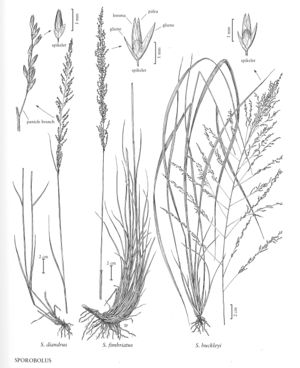Difference between revisions of "Sporobolus buckleyi"
FNA>Volume Importer |
imported>Volume Importer |
||
| (2 intermediate revisions by the same user not shown) | |||
| Line 39: | Line 39: | ||
|publication year= | |publication year= | ||
|special status= | |special status= | ||
| − | |source xml=https:// | + | |source xml=https://bitbucket.org/aafc-mbb/fna-data-curation/src/200273ad09963decb8fc72550212de541d86569d/coarse_grained_fna_xml/V25/V25_675.xml |
|subfamily=Poaceae subfam. Chloridoideae | |subfamily=Poaceae subfam. Chloridoideae | ||
|tribe=Poaceae tribe Cynodonteae | |tribe=Poaceae tribe Cynodonteae | ||
Latest revision as of 17:58, 11 May 2021
Plants perennial; cespitose, not rhizomatous. Culms 40-100 cm. Sheaths keeled and flattened below, margins occasionally hairy distally, hairs to 1.2 mm; ligules 0.2-0.4 mm; blades 12-35 cm long, 4-12 mm wide, flat, glabrous abaxially, scabridulous adaxially, margins smooth or scabridulous. Panicles 15-50 cm long, 7-22(30) cm wide, diffuse, ovate; primary branches 2-17 cm, spreading 40-100° from the rachis; secondary branches appressed to loosely spreading, without spikelets on the lower 1/4 - 1/2; pulvini glabrous; pedicels 0.2-1.2 mm, appressed, scabridulous. Spikelets 1-2 mm, purplish to brownish. Glumes unequal, narrowly lanceolate to lanceolate, membranous, prominently keeled; lower glumes 0.6-1 mm; upper glumes 1.1-1.8 mm, slightly shorter than or subequal to the lemmas; lemmas 1.2-2 mm, lanceolate, membranous, glabrous, acute; paleas 1.2-2 mm, ovate, membranous, glabrous, often splitting in two between the veins at maturity; anthers 0.2-0.4 mm, purplish. Fruits 0.6-1 mm, ovoid, slightly flattened, reddish-brown. 2n = 40.
Discussion
Sporobolus buckleyi grows between 0-150 m, in loamy soils near the margins of woods or thorn scrub, sometimes in partial sunlight. Its range extends from southeastern Texas to Belize.
Selected References
None.
